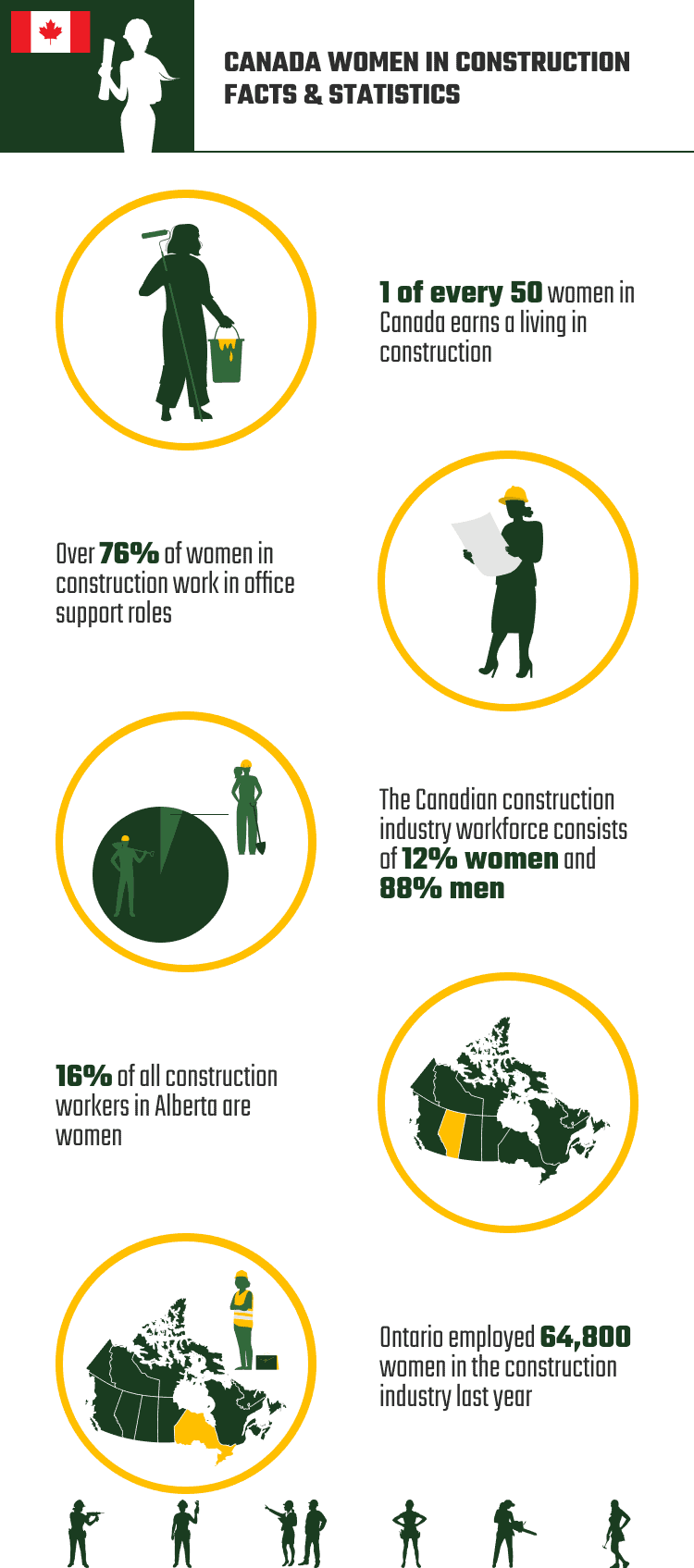11 Women in Construction Statistics in Canada: Updated in 2025
-
Chantelle Fowler
- Last updated:

Note: This article’s statistics come from third-party sources and do not represent the opinions of this website.
The construction industry in Canada is booming. According to Randstad, there has been a 50% increase in construction-related jobs over the past decade. Since Canada’s economy and population continue to rise, the demand for infrastructure to support the growing country is high. Since there are plenty of job opportunities, construction is an excellent trade for both men and women to consider entering.
Unfortunately, women are vastly outnumbered in many trade industries, including construction. Statistics suggest, however, that the number of women in the industry is on the rise. Keep reading to find 11 fascinating statistics about women in construction in Canada.
Click below to jump ahead:
The 11 Women in Construction Statistics in Canada
- One of every fifty women in Canada earns a living in construction.
- Over 76% of women in construction work in office support roles.
- The Canadian construction industry workforce consists of 12% women and 88% men.
- 189,300 Canadian women were working in the construction industry in 2021.
- 16% of all construction workers in Alberta are women.
- Only 400 women were employed in the construction industry in Prince Edward Island in 2021.
- Ontario employed 64,800 women in the construction industry in 2021.
- Quebec employed 6,234 women in the construction industry in 2021.
- Women earn 89% of men in the mechanical trades industry.
- Women with electrical trade certifications earn 15% less than their male counterparts.
- Women in welding make 84% of what men make in their first year of work.

Women That Make Up the Construction Industry
1. One of every fifty women in Canada earns a living in construction.
(Build Force Canada)
The construction industry doesn’t seem to be slowing down in Canada. One in 13 Canadian workers is currently employed in the industry, while one in 50 Canadian women earns a living in construction. This number is up considerably from 40 years ago when just one in every 77 women worked in the industry.

2. Over 76% of women in construction work in office support roles.
(Build Force Canada)
The majority of the women who work in construction work in off-site occupation roles. Over 76% of women in the industry perform business administration work, management, and sales. This leaves over three-quarters of the industry’s women in office support roles, accounting for nearly 40% of the off-site workforce.
3. The Canadian construction industry workforce consists of 12% women and 88% men.
(Build Force Canada)
Though the construction industry is dominated by men in Canada, women make up 12% of the workforce. However, since most of the women employed in the sector are employed off-site, women’s share of on-site occupational employment is only approximately 4%.
4. 189, 300 Canadian women were working in the construction industry in 2021.
(Statistics Canada)
In 2021, 189,300 Canadian women worked in the construction industry. This number has been on a slow incline since 2017 when there were 173,300 women employed in the industry. In comparison, the number of men working in the industry in 2021 topped 1.24 million.
 Statistics By Province
Statistics By Province
5. 16% of all construction workers in Alberta are women.
(Alberta Labour and Immigration)
Women accounted for 16% of the construction workforce in Alberta in 2020. There were 34,300 women employed in the industry that year, while the other 84% were men. The construction industry in the province accounted for 7.0% of the Gross Domestic Product for Alberta in 2020, a decline from 9.6% in 2010.

6. Only 400 women were employed in the construction industry in Prince Edward Island in 2021.
(Statistics Canada)
In 2021, only 400 women on Prince Edward Island held jobs in the construction industry. This is down from previous years. In 2019 and 2020, 700 women were working in construction on the island. The health care and social assistance sector employed the most females at 9,500 in 2021, an increase from previous years.
7. Ontario employed 64,800 women in the construction industry in 2021.
(Statistics Canada)
Ontario employed the most women in the construction industry of any province in 2021. About 64,800 women worked in the sector in 2021, a number that remained stable from the previous year. In 2018, 67,400 Ontario women worked in the industry.
8. Quebec employed 6,234 women in the construction industry in 2021.
(Commission de la construction du Québec)
Quebec employed 6,234 women in various construction industry jobs in 2021. This is up significantly from previous years, as 4,873 women were in the industry in 2020, and only 2,191 females worked in the sector in 2012. The most female-populated job in Quebec’s construction sector was painting with 1,522. The next most populated job was that of a joiner, with 1,168 females employed in 2021.
Salary of Women in Construction
9. Women earn 89% of men in the mechanical trades industry
(Labour Market Information Council)
The smallest earning gap between genders is in the mechanic trade, where women earn 89% of men. Men generally earn $84,100, while their female counterparts would earn $74,500. While in the architecture trade, women earn 78% of what men do ($72,500 versus $84,100).

10. Women with electrical trade certifications earn 15% less than their male counterparts
(Policy Options)
On average, women in the electrical field earn $72,500 eight years after gaining their certification. Men certified in the same trade earn $85,100 over the same period.
Of course, this gender pay gap is not explicitly reserved for construction or even the trades in general. There is a pay gap between men and women across almost all industries.
11. Women in welding make 84% of what men make in their first year of work.
(Canadian Metal Working)
Women working in higher paying trades such as welding tend to fare better than women in other construction-related industries, at least regarding wages. For example, women in welding make 84% of what their male counterparts make in the first year.
At $61,000, a woman’s average earnings in the welding industry are among the highest of all post-secondary students in the first year after convocation.
Frequently Asked Questions About Women in Construction in Canada
What type of work do women do in the construction industry?
A woman can take on any role in the construction industry. Women can handle the same power tools and operate the same machine as men, so their careers in construction can take any form they wish. Some women love building things and working with their hands, while others prefer to stick behind the scenes.
Women that prefer hands-on jobs will need some form of post-secondary education to get the experience and knowledge they need to succeed at their job. However, this isn’t specific to women, as men should also seek formal education before entering the industry.
What jobs are available in the construction industry for women?
Women can do any of the same construction jobs as their male counterparts. The construction sector is enormous, and there are many different routes one can take depending on their skills and passions.
Construction laborers perform physical labor at construction sights, while brick masons use materials like concrete to build offices and walkways. Carpenters create wooden structures, while electricians install and repair electrical structures. Other career options include architecture, cabinet making, drywall finishing, millwrighting, and roofing.
These jobs require a lot of hands-on training, which is why taking an apprenticeship is essential to getting into the industry.

How can women get into the construction industry in Canada?
Many schools offer construction courses, degrees, and diplomas throughout Canada. Someone interested in getting into the industry should first narrow down what sector of the industry they’re interested in working in.
Once they know what type of work they’d like, they can research schools that offer programs in line with their interests. Some institutions offer free or lower-cost apprenticeship programs to get young women interested in the trades.
What is the Canadian government doing to increase the number of women in trades?
In 2019, Canada’s Building Trades Unions (CBTU) launched Offices to Advance Women Apprentices (OAWA) in several provinces, including Manitoba, Saskatchewan, and Nova Scotia. Other areas, like Newfoundland and Labrador, New Brunswick, PEI, and Nova Scotia, already had OAWA programs in place.
The 2019 announcement promised to provide $3.1 million to help female workers in apprenticeships through 2023.
This program is designed to support tradeswomen looking for work and those already employed in the skilled trades. (Globe News Wire)
Conclusion
The number of females working in the construction industry in Canada is on the rise, but women are still vastly outnumbered by men. Women still experience discrimination in the trades workforce and have many barriers they need to overcome to be accepted in the workplace.
Many organizations exist to assist women interested in entering a male-dominated field. The goal is for Canadian women to take advantage of these resources to continue paving the way for themselves in the construction industry.
See Also:
Featured Image Credit: Jumpstory
Contents



